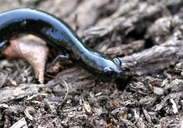|
Oedipina gephyra McCranie, Wilson & Williams, 1993
La Fortuna Worm Salamander Subgenus: Oedopinola | family: Plethodontidae subfamily: Hemidactyliinae genus: Oedipina |
 © 2010 Josiah H. Townsend (1 of 1) |
|
|
|
Description Diagnosis: O. gephyra can be distinguished from other species of Oedipina in Honduras by the presence of 17 or 18 costal grooves. Oedipina elongata is the exception. O. gephyra is distinguishable from O. elongata by the presence of maxillary teeth which O. elongata does not have. O. gephyra has a dorsum that is uniformly blackish-brown, while Oedipina elongata has a brown dorsum with lighter brown spots or patches on the head and on the body (McCranie et al. 1993; McCranie and Wilson 2002). Coloration: O. gephyra is uniformly blackish-brown throughout, and the tail is black. Tiny iridophores are visible under magnification (McCranie et al., 1993). Variation: Males have mental glands and premaxillary teeth that pierce the lip. In females, the premaxillary teeth are located behind the lip. Males have cloacal papillae, while females have shallow cloacal folds (McCranie and Wilson 2002). Distribution and Habitat Country distribution from AmphibiaWeb's database: Honduras
Life History, Abundance, Activity, and Special Behaviors Trends and Threats Possible reasons for amphibian decline General habitat alteration and loss Comments The species name, gephyra, is derived from Greek root word that means “bridge.” The name refers to the fact that O. gephyra has several morphological features that bridge the gap between the species groups Oedipina uniformis and Oedipina parvipes . This was recognized by Brame when he revised the genus Oedipina in 1968 (McCranie et al. 1993; McCranie and Wilson, 2002). The sister species of O. gephyra are Oedipina elongata and Oedipina carablanca (McCranie et al. 2008).
References
Frost, D. (2011). Amphibian Species of the World: an Online Reference. Version 5.5. McCranie, J. R. and Casteñeda, F. E. (2005). ''The herpetofauna of Parque Nacional Pico Bonito, Honduras.'' Phyllomedusa, 4(1), 3-16. McCranie, J. R., Vieites, D. R., and Wake, D. B. (2008). ''Description of a new divergent lineage and three new species of Honduran salamanders of the genus Oedipina (Caudata, Plethodontidae).'' Zootaxa, 1930, 1-17. McCranie, J. R., and Wilson, L. D. (2002). ''The Amphibians of Honduras.'' Contributions to Herpetology, Vol 19. K. Adler and T. D. Perry, eds., Society for the Study of Amphibians and Reptiles, Ithaca, New York. McCranie, J.R., Wilson, L.D. and Williams, K.L. (1993). ''A new species of Oedipina ( Amphibia: Caudata: Plethodontidae) from northern Honduras.'' Proceedings of the Biological Society of Washington, 106, 385-389. Originally submitted by: Rebecca Polich, Laura Van Vranken, and Anthony Rodriguez (first posted 2011-04-21) Edited by: Mingna (Vicky) Zhuang (2012-03-22) Species Account Citation: AmphibiaWeb 2012 Oedipina gephyra: La Fortuna Worm Salamander <https://amphibiaweb.org/species/4107> University of California, Berkeley, CA, USA. Accessed Apr 23, 2024.
Feedback or comments about this page.
Citation: AmphibiaWeb. 2024. <https://amphibiaweb.org> University of California, Berkeley, CA, USA. Accessed 23 Apr 2024. AmphibiaWeb's policy on data use. |



 Raffaëlli Account
Raffaëlli Account Map of Life
Map of Life